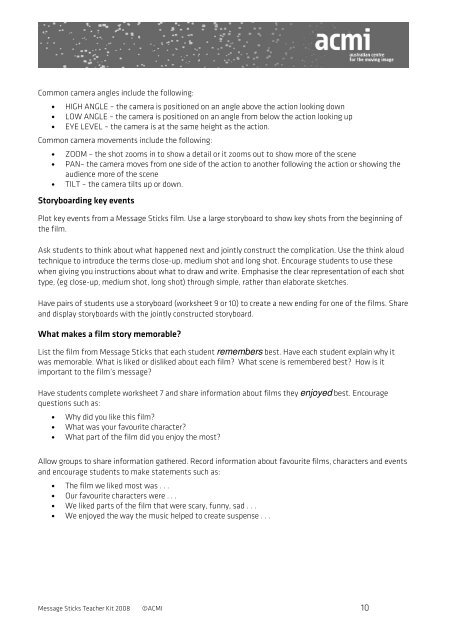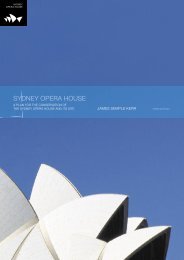July 2 â 3 - Sydney Opera House
July 2 â 3 - Sydney Opera House
July 2 â 3 - Sydney Opera House
You also want an ePaper? Increase the reach of your titles
YUMPU automatically turns print PDFs into web optimized ePapers that Google loves.
Common camera angles include the following:<br />
• HIGH ANGLE – the camera is positioned on an angle above the action looking down<br />
• LOW ANGLE – the camera is positioned on an angle from below the action looking up<br />
• EYE LEVEL – the camera is at the same height as the action.<br />
Common camera movements include the following:<br />
• ZOOM – the shot zooms in to show a detail or it zooms out to show more of the scene<br />
• PAN– the camera moves from one side of the action to another following the action or showing the<br />
audience more of the scene<br />
• TILT – the camera tilts up or down.<br />
Storyboarding key events<br />
Plot key events from a Message Sticks film. Use a large storyboard to show key shots from the beginning of<br />
the film.<br />
Ask students to think about what happened next and jointly construct the complication. Use the think aloud<br />
technique to introduce the terms close-up, medium shot and long shot. Encourage students to use these<br />
when giving you instructions about what to draw and write. Emphasise the clear representation of each shot<br />
type, (eg close-up, medium shot, long shot) through simple, rather than elaborate sketches.<br />
Have pairs of students use a storyboard (worksheet 9 or 10) to create a new ending for one of the films. Share<br />
and display storyboards with the jointly constructed storyboard.<br />
What makes a film story memorable?<br />
List the film from Message Sticks that each student remembers best. Have each student explain why it<br />
was memorable. What is liked or disliked about each film? What scene is remembered best? How is it<br />
important to the film’s message?<br />
Have students complete worksheet 7 and share information about films they enjoyed best. Encourage<br />
questions such as:<br />
• Why did you like this film?<br />
• What was your favourite character?<br />
• What part of the film did you enjoy the most?<br />
Allow groups to share information gathered. Record information about favourite films, characters and events<br />
and encourage students to make statements such as:<br />
• The film we liked most was . . .<br />
• Our favourite characters were . . .<br />
• We liked parts of the film that were scary, funny, sad . . .<br />
• We enjoyed the way the music helped to create suspense . . .<br />
Message Sticks Teacher Kit 2008 ©ACMI 10

















